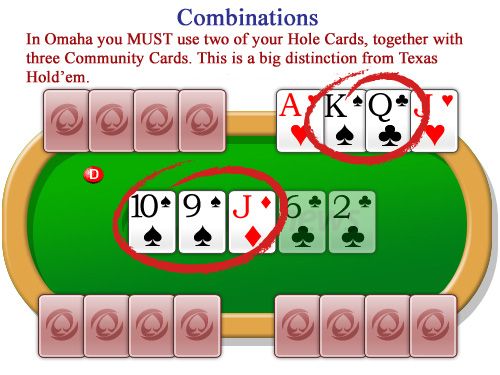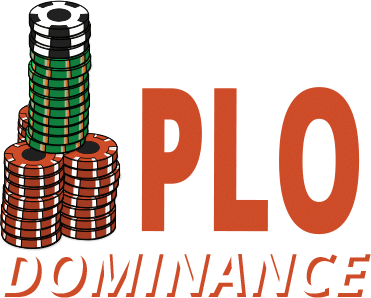The betting in PLO is different from NLH. The minimum a player can bet is the same amount as the player who most recently acted. If the last bet was 10 you can call that bet or raise to 20. The maximum bet is the size of the pot, which is why it’s called Pot Limit Omaha. PLO Rules Omaha Hold’em, commonly known as Omaha, is currently the second most played variant of poker in the world, right after Texas Hold’em. Omaha has traditionally been played in Europe but in recent years it has also become a mainstream form of poker both in the United States and online.
The Basic Rules of Pot Limit Omaha (PLO)
Omaha is a poker variant in which each player is dealt four “hole” cards (cards that the other players can’t see) and then share a five card board. It is similar to Hold’em in its play, with flop, turn, and river cards dealt in succession on the board, interspersed with betting rounds. The most common betting structure for Omaha is Pot Limit, in which players can only bet the size of the pot, including their call.
The play begins with each player being dealt four cards. Unlike Hold’em, players must play exactly two cards from their hand and exactly three from the board. Hand rankings are the same in Omaha and Hold’em, with a high card being the worst and a royal flush the best possible hand.

In PLO, the play starts with a small and big blind, which rotates each turn. The first player after the big blind (Under the Gun – UTG) may fold, call the big blind, or raise up to the “pot limit.” If the blinds are $1 and $2, the UTG player can bet up to $7. Things then get a little tricky. The second player can now fold, call the $7 or bet up to $24. This betting structure takes a while to get used to. See our How to Calculate Pot Limit article for more examples. When in doubt, if you would like to bet the maximum, you can always announce that you bet “pot” and the dealer will figure out the amount for you.
Note that starting hand values are quite different than in Hold’em, so you’ll want to familiarize yourself with these differences before playing Omaha. The “Advice” button in our PLO simulator can help you with this.
Hand equities run much closer together in Omaha, and thus more players will generally stay to see the flop than in Hold’em. With the ability to select the best two of a four card hand, winning hands in Omaha also tend to be quite strong. Single pairs and two pairs are rarely likely to take down the pot, and players should be drawing to nut straights and flushes if they decide to draw.
As you might imagine, Omaha pots can grow quite big, and with pre-flop hand equity advantages rarely larger than 60% variance swings in PLO can be big as well. The PLO player will need a larger bankroll than the typical No-Limit Hold’em player for that reason.

Read all our instructional articles

Rules of the Game
Pot Limit Omaha (PLO) is the second most popular poker game in the world. Ten years ago it was somewhat difficult to find a live game going outside of Europe but now many card rooms spread PLO regularly. While it will never surpass No Limit Hold’em (NLHE) in popularity it will only increase its market share as the years move forward. Everyday people are converting to PLO as their game of choice.
Plo Hi Rules
It’s not hard to figure out why this is the case as PLO is an action game where all players get dealt four cards and possibilities abound. One caveat, however, is that you must use at least two of your hole cards in your final hand. In other words if you have A♥ K♦ J♠ J♣ you don’t have an ace high flush when the board shows four hearts. Also you do not have a full house if the board is K♥ K♠ 5♣ 5♦ 2♥. So if you are new to the game make sure you have these fundamentals firmly in mind before heading out to the tables as the game is enough intimidating on its own for inexperienced players.
Basic Strategy
Plo 5 Rules

Starting hand selection is incredibly important; mediocre starting hands tend to build mediocre holdings and the second best hand can cost you a lot of money. There is no place ticket in PLO; the second best hand always loses the most money.
The premium hands have both nut potential and have all four cards working together such as A♥ K♥ Q♠ J♣, A♥ A♦ J♠ T♠, and K♦ Q♦ J♣ T♣. These hands play very well heads-up or multi-way but obviously hands like this do not grow on trees. Hands like A♥ 9♥ 8♠ 7♣, T♥ 9♥ 8♠ 6♣, and Q♦ Q♠ T♠ 9♣ are also quite good because you tend to either hit a favorable flop and when you don’t you are usually able to get out without committing too many of your troops.
This is not a split pot game so run downs with no gaps and at least one suit down to around 8♠ 7♠ 6♥ 5♣ has a lot of value in this game. It is important, however, to not overrate any rundowns lower this this because you are beginning to run into the danger of continually running into higher straights. Being suited at least once is important because when you share a nut straight with someone else it can give you the highly desired free-roll. If someone happens to hold a higher flush draw then you suits act as blocking defense.
Pot Limit Omaha is too complicated of a game to get too in depth here but here are some quick warnings that new players should heed so they can learn the game without paying too high of a tuition:
- In a multi-way pot you always want to be drawing to the nuts. For example, drawing to a jack high flush with five players in the pot is a recipe for disaster.
- Beware of medium and low pairs and the sets that they make. You will run into higher sets more often than you think and they are big time money losers. Starting hands with them should most often be folded, although there are exceptions such as A♥ A♦ 2♣ 2♠ and T♥ 9♥ 8♠ 8♣. If you happen to flop a set of deuces or eights with either of these hands you must be aware that you could be in peril. Certainly you do not have to automatically fold but recognize that your hand is not as strong as it is in NLHE.
- Straight draws even with those with many outs (i.e. wraps) are severely devalued when there are two suits on board. You can call a bet, but if you if raise that can allow a player with a set, two pair and a flush draw, or a flush draw that shares some of your straight outs to reopen the betting and your holding fares very badly against such hands.
- Do not overvalue dry aces (e.g A♥ A♠ 7♦ 3♣) and put too much money into the pot pre-flop especially when stacks are deep. If you give away the fact that you have aces you allow your opponents to more or less play perfectly against you. Of course if you have premium aces you should escalate the pot for value but make sure other hands without aces are in your range.
- Many new players are enamored with the “Bare Ace Bluff”. This is the play where you only have one ace of a suit when there are three more on board and play too aggressively every time in the hopes of getting everyone to fold because they can’t have the nuts. This play should be made on occasion but overdoing can be very costly as many players are on guard for such a play and hate to be bluffed out.
- Many beginning resources go out of their way to tell you that hands with big pairs and nothing much else such as K♥ K♠ 5♦ 4♣ are unplayable because your hand is not working together. While it is true that this holding is far from a premium holding you should definitely try and see a flop unless the pot is raised and re-raised and it costs too much as a relative portion of your stack to consider calling. Top set is a premium hand with which you typically have both the best hand and the best draw which is the best situation in poker. In raised pots you can sometimes stack an opponent who commits too much money with a lesser hand and can’t give it up.
Further Learning
Plo6 Rules
Pot Limit Poker: The Big Play Strategy by Jeff Hwang, (Rating 10/10) – This book is an excellent resource on learning how to best approach live full ring PLO games. In addition, it also has excellent beginning material on Pot Limit and Limit Omaha Eight or Better.
Advanced Pot-Limit Omaha Volume I, Volume II, and Volume III by Jeff Hwang, (Rating 7/10) – These books are also highly valuable because they have some nuggets of very good information and have an immense amount of examples yet they appear to have a few shortcomings. In many examples Jeff advocates calling re-raises too much with dominated hands especially out of position. In other situations he is also putting in too much money with very marginal hands in an attempt to isolate or is calling too wide pre-flop in an attempt to play “small ball”. Often you will end up in a three way pot with a very marginal hand and while position does help it’s often the case you are up against two better hands.
Mastering Pot-Limit Omaha: The Modern Aggressive Approach by Herbert Okolowitz and Wladmir Taschner (Rating 8/10) – If online PLO is your game then this resource is for you. Great information and advice for those that play the more aggressive and advanced online games that tend to feature six-handed play.